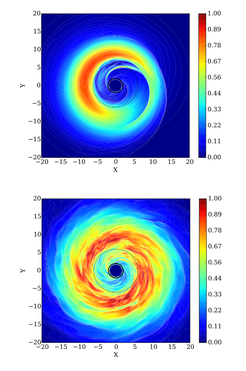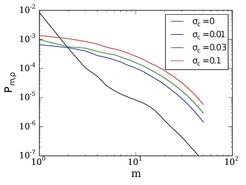Instabilities in relativistic magnetized accretion disks
Neutron stars are fairly exotic objects with a density equal to the one found in atomic nuclei. But if two neutron stars merge, an even more exotic object can be the result: a black hole-torus system might form, where a thick disk orbits around the central compact object, emitting highly energetic radiation and feeding mass to the black hole. These thick accretion disks are prone to develop a number of instabilities that shape their structure and determine their properties.

Figure 1: Equatorial cuts of the rest mass density for the hydrodynamic (top) and magnetized (bottom) models after 15 orbital periods. The solid black curve represents the black hole event horizon, while the dotted black curve indicates the radius of the last marginally stable orbit.
In the absence of magnetic fields, they can experience the so-called "Papaloizou-Pringle instability" (PPI), which leads to the growth of non-axisymmetric perturbations in the disk. From these a characteristic planet-like structure will form that orbits around the central object. Recent numerical hydrodynamic simulations performed in the framework of General Relativity show that such an instability can develop quite generally, possibly leading to a detectable emission of gravitational waves.
The dynamics of the disk can change significantly when magnetic fields are present, because they trigger the so-called "magneto-rotational instability" (MRI). This phenomenon is regarded as one of the main mechanisms driving accretion in a number of astrophysically relevant scenarios, such as active galactic nuclei and X-ray binary systems. There, MRI leads to the growth of linear perturbations on dynamical time scales and magnetic turbulence.
For the first time, astrophysicist at the MPA systematically studied the interplay between these two kinds of instabilities in relativistic disks orbiting around a black hole. Their goal was to better understand how these instabilities interact and whether one dominates over the other. Using three-dimensional general relativistic magneto-hydrodynamic (GRMHD) simulations, they investigated how accretion tori evolve, which are threaded by a purely toroidal magnetic field of various strengths. The magnetic field was always sub-thermal, i.e. the magnetic pressure was 1% to 10% of the thermal pressure. All simulations were performed with a highly parallelized version of the "ECHO" code.
In the hydrodynamic case, the PPI develops undisturbed and a characteristic large-scale, non-axisymmetric mode dominates throughout the whole simulation. The inclusion of magnetic fields triggers the growth of a MRI, which develops faster than the PPI. The smooth flow present in the unmagnetized model is replaced by a turbulent plasma, where small scales are excited and there is no clear evidence of a planet-like structure orbiting around the black hole (see Fig. 1).

Figure 2: Time-averaged rest mass density spectra as a function the mode number m, which indicates the scale of an instability. The black curve represents the hydrodynamic model; here a prominent peak is present for m=1 which is equivalent to a large-scale ordered flow. The coloured solid curves refer to magnetized models, where turbulence is present on a wider range of scales. The parameter c represents the value of magnetization (ratio of magnetic to thermal pressure) at the disk's centre.
The time-averaged density spectra (Fig. 2) show the difference between the scale-distribution of the resulting turbulence: in hydrodynamic disks a dominant peak is present for the largest scales, which disappears in all magnetized models. The MHD turbulence excites a wider range of scales, leading to shallower spectra, while there are no substantial differences in the shapes of the spectra for different levels of magnetization.
The simulations show that also the time frame changes. When the disk is threaded by a magnetic field, the MRI leads to a faster onset of accretion onto the central black hole. In this case, the transport of angular momentum towards the outer parts of the disk happens on a shorter time scale than in the hydrodynamic case.
In all magnetized models the PPI appears to be severely quenched by the action of the MRI. This is probably due to the fact that the MRI quickly changes the local conditions in the disk, by transporting angular momentum outwards and establishing a turbulent environment where conditions are no longer favourable for the PPI to form.
However, if the MHD turbulence is not well resolved (and hence the magnetic field gets more diffused) the suppression of the PPI appears to be less effective. This behaviour is observed only in lowly magnetized disks, since models with a higher magnetization have a large characteristic wavelength of the MRI and less grid points are required to properly resolve it.
The findings from the simulations suggest that in the presence of dissipative effects - whether they are due to numerical limitations or physical phenomena - the PPI may still give rise to a significant large-scale turbulence. The next step in this study will therefore focus on the possible role that turbulent magnetic diffusivity may play in the disk's evolution.
Future work could also take into account the self-gravity of the disk. Non-linear interactions between the central black hole and the torus can excite additional PPI modes and hence reinforce the growth of non-axisymmetric structures in the disk. These would directly affect the gravitational wave signal emitted by the system.
Note:
The parallelization of the "ECHO" code was developed by Matteo Bugli (MPA) in collaboration with Fabio Baruffa (Leibniz-Rechenzentrum) and Markus Rampp (Max Planck Computing and Data Facility).













